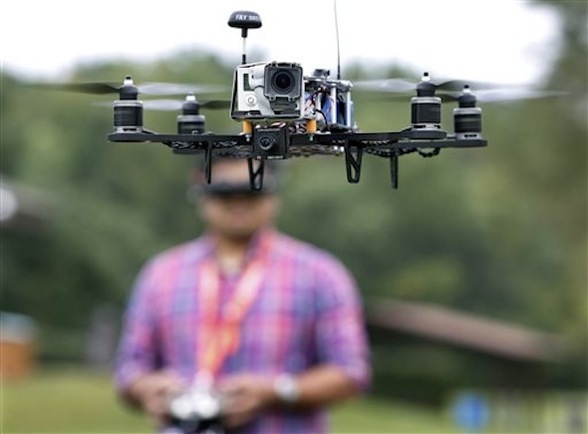 Takeoff Kevin Vertucio, of Bristol, Pa., practices flying his “quadcopter” while wearing goggles connected to the small camera seen at the bottom center of the craft. The larger camera, above, makes videos during the flight. Trained as an electrical engineer, Vertucio, uses the aircraft to make aerial photographs for casinos and other companies. (AP Photo/Mel Evans)
Takeoff Kevin Vertucio, of Bristol, Pa., practices flying his “quadcopter” while wearing goggles connected to the small camera seen at the bottom center of the craft. The larger camera, above, makes videos during the flight. Trained as an electrical engineer, Vertucio, uses the aircraft to make aerial photographs for casinos and other companies. (AP Photo/Mel Evans)
CNN’s research program for drone journalism has been cleared for takeoff, but don’t expect Anderson Cooper-narrated live aerial shots any time soon.
On Monday, the network announced a partnership with the Federal Aviation Administration to study how news organizations can safely use the nascent technology in US airspace. CNN will work with academic experts and public agencies to discover best practices for newsgathering-by-drone, sharing information with federal regulators in the process.
The machines represent a potential game-changer for news coverage of live events, difficult terrain, or dangerous areas. As CJR wrote in May, they “could fundamentally transform a journalist’s ability to tell stories.” But while a number of individuals and organizations have begun experimenting with drones, CNN is the first major American media outlet to take formal legal steps toward exploring those possibilities. Several bureaucratic hurdles remain, however, before any of the network’s drones will actually take flight, even for research. “This is the beginning of a process,” CNN Senior Vice President David Vigilante said in an interview.
“Our holy grail is the ability to fly for extended periods using professional-grade cameras and return high-definition videos to the ground, live,” he said. “Putting up a GoPro for five minutes just isn’t the same. For breaking news, it just doesn’t meet our needs.”
That holy grail is not yet on the horizon, of course. Yet a number of news organizations reporting Monday on CNN’s agreement with the FAA implied that the appearance of drone footage on airwaves was imminent. What the partnership actually allows is for CNN to conduct authorized trials at controlled sites with an academic partner. The network teamed up in June with the Georgia Tech Research Institute, a leader on drone research located near CNN headquarters in Atlanta.
“We’ll go to some isolated site away from anybody so we can work out all the problems safely,” said Mike Heiges, principal research engineer at the Georgia Tech Research Institute. “CNN won’t be using the footage for commercial purposes. All the activity with us is just the research.”
The FAA faces a September deadline to begin unveiling regulations for domestic use of unmanned aerial vehicles—the government’s clunky parlance for “drones.” Though the technology has gained infamy in recent years as a tool of the US military and intelligence agencies, its private-sector possibilities range from agriculture to real estate to filmmaking. Current federal rules prohibit drone use for such commercial purposes, including journalism, with regulators citing a need for better “understanding of operational issues, such as training requirements, operational specifications, and technology considerations.”
In March, news organizations including The New York Times, Associated Press, and others argued in a brief to the National Transportation Safety Review Board that “This [current] overly broad policy … has an impermissible chilling effect on the First Amendment newsgathering rights of journalists.”
Until the FAA rolls out its new regulations, the agency can indeed grant narrow exemptions to the rules through Certificates of Authorization, which go to public operators like law enforcement agencies and state universities. The Drone Journalism Lab at the University of Nebraska-Lincoln is applying for its certificate, for example, while CNN’s partnership with Georgia Tech allows it to share exemptions with the research institution.
“We hope this agreement with CNN and the work we are doing with other news organizations and associations will help safely integrate unmanned newsgathering technology and operating procedures into the National Airspace System,” FAA Administrator Michael Huerta said in a statement.
CNN will initially test three types of drones—small, medium, and large options—said Vigilante, CNN’s top lawyer. One will be able to fly for 55 minutes at a time and another will be tethered to a power source on the ground, allowing it to hover for extended periods. At least one of the models has yet to be cleared by the FAA, Vigilante added, a process that could take months.
Once the news organization’s drones eventually do take to the skies, CNN and Georgia Tech’s experts will conduct some of their exercises with local law enforcement to prepare for coverage of crime scenes and traffic accidents, among other scenarios. Information culled from the research will likely aid the FAA in devising its regulatory structure for low-altitude airspace. What’s more, the trials will help CNN hone aircraft design and iron out any technical kinks before footage is actually transmitted to viewers.
“There’s a big engineering side of this that doesn’t get a lot of attention,” Vigilante said. “How do you get the signal from the bird to the ground to the truck to the studio without compromising signal quality?”
He added that the news organization may be able to operate the technology overseas before the FAA clears it for US airspace. Until then, the potential for drone journalism will remain in check. And CNN’s counterparts will simply have to wait and see how long their own flights are delayed.
“We’re excited about it,” Vigilante said. “But it’s going to take time.”
David Uberti is a writer in New York. He was previously a media reporter for Gizmodo Media Group and a staff writer for CJR. Follow him on Twitter @DavidUberti.
